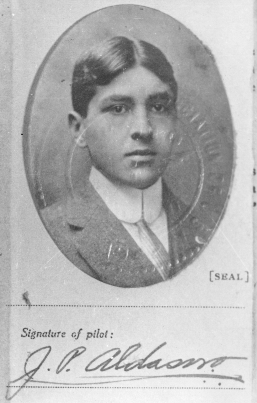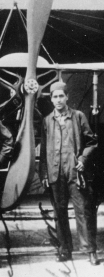 |
Juan
Pablo Aldasoro Suárez was born in the "Casa Grande" of Real of Monte,
State of Hidalgo (Mexico) the 14 of September of 1893, and in the same
place his brother saw the light for the first time
Eduardo Aldasoro Suárez, the 27 of
October of 1894. They we born to an upper class family, their father
Ing.
Andrés Aldasoro was Minister of Promotion
under Porfirio Díaz and was General Manager of the Mine "Las Dos
Estrellas" in the state of Michoacán. The inseparable brothers
alternated their studies of preparatory with their vocation to the mechanics
and the flight, and through publications and magazines of those days time
they inquired researched about everything related to aviation. By
1908 they began to plan and to construct their first gliders which were
tested in some fields near the Piedad Cemetery (Panteón de la Piedad,
now Avenida Cuauhtémoc). They achieved brilliant results as
they managed to flight around one hundred meters in their own designed
gliders.
|
|
They
used diverse methods for the propulsion: the glider was towed by
a steam automobile that reached a terminal velocity of 50 Kms. per hour.
The structure of the plane was made of wood, the wings were covered
by blanket fabric hardened with engrudo and the landing gear
was adapted from steel tubes and bicycle wheels. The gliders were
cautiously hidden, to avoid someone else stealing their design, they
covered them with linen cloths.
|
 |
The tests were verified in different hours, mainly
at dawn. In his first flights used mandiles of leather as protection
for the landing, since the gliders were severely damaged after each flight.
The 9 of
March 1909 was a very important
day for the Aldasoro brothers, that day they took the glider towards the
outskirts of Mexico City, nowadays Calle de Querétaro in
Colonia
Roma, this was the first street to be opened in the neighbourhood and
for them it represented a nice track without obstacles. They tied the glider
to steam car "White" which was the fastest automobile of those days. Juan
Pablo would be the pilot and his brother Eduardo would be in charge of
driving the car that would tow the glider.
As they started moving, a huge cloud of dust arose, the glider slowly elevated the tail and finally emerged from the cloud. The car continued moving for about 300 meters and then slowly decreased the speed to allow the glider loosen the cable and then continue flying. Suddenly something unexpected happened. The device to release the cable did not worked properly and Juan Pablo went flying above car without being able to free himself. As the plane continued, the cable pulled it back and immediately turned in a somersault and crashed against the ground. The glider was destroyed and, miraculously, Juan Pablo was alive with a fractured leg. The experience drawn from this flight was extraordinary, the pilot had managed to have absolute control of the glider for more than 480 meters as well as a very stable flight at a height of 10 meters!
This accident and others undergone by Eduardo, did not discouraged them at all. On the contrary, having seen that their planes were able to fly, they decided to construct an engine that could be adapted into an aeroplane. With this intention in mind, they travelled to the mine of "Las Dos Estrellas" , in Tlalpujahua, Michoacán, where his father was the manager. They took with them drafts and designs and used the welding and smelting facilities of the mine to construct the motor of the internal combustion with two opposite cylinders. At that time, the existing engines were very heavy and voluminous, they had enormous radiators for cooling, and many of accessories that did not satisfy the required characteristics to impel an aeroplane.
Finally, in January
1911 they finished the construction and testing
of the motor, cooled by air, it could develop 60 h.p. and up to
900 RPM. The basic feature was its weight: 3 kilos per h.p.
They constructed a very rudimentary "wind
tunnel" to help them study the process
of flying. They experimented with different shapes and angles for the wings
as well as their centre of gravity. Years before other European designers,
they designed the "thick wing", which was highly efficient. They
had solved the aerodynamics of the plane. Once assembled all the
components, the aeroplane with engine was ready.
 |
When
the aeroplane was finished, the Minister of War to President Madero, General
Angel García Peña, inspected
the plane very carefully. He decided that before testing it, Juan
Pablo and Eduardo Aldasoro should be granted a scholarship by the
Government of Mexico to attended the Moissant
Aviation School in New York. The
President of Mexico Don Francisco I.
Madero was a progressive and visionary man,
he thought that aviation offered great possibilities to create a modern
army, about which the vocation, the professional formation and a pure patriotic
spirit of youth, served as incentive to renew people, styles and customs
of the past. Then, the Aldasoro brothers accompanied by Alberto Salinas
Carranza, Gustavo Salinas Camiña y Horacio Ruiz, travelled
to the USA and were the first mexicans to graduate as Pilots on 12
March 1913. The Fédération
Aéronautique Internationale granted the licenses 217 to Juan
Pablo Aldasoro and 218 to Eduardo Aldasoro. The graduation day, the authorities
were to authorise for one of the recent pilots to fly over the Statue
of Liberty.
|
 |
The Air and Space Museum in Washington DC pays tribute to these pilots who contributed with courage and sacrifice to the History of Aviation. All those who who flew "Solo" before 1916 are part of the Early Birds. |
|
Mexican
Aviation is proud that Juan Pablo and Eduardo Aldasoro were members
of the Early Birds.
|
 |
|
President
Madero did not have the opportunity to see his dream fulfilled, but
those five pioneers, Juan Pablo and Eduardo Aldasoro, Alberto and Gustavo
Salinas and Horacio Ruiz, would become the pillars of the glorious Mexican
Air Force, not only as founders, but also, teachers of the next generations.
The Department of Military Aeronautics, the School, the National Factories
of Aeronautical Constructions and the own Mexican Air Force, had in them
to their pillars, their guides. In these institutions they committed
their lives and work.
|
 |
Juan Pablo Aldasoro Suárez passed away the 4 of October of 1962 with the degree of Lieutenant Colonel Flying Pilot.
Eduardo Aldasoro Suárez passed
away the 10 of November of 1968, with the degree of General Brigadier
Flying Pilot.
This web page was developed by Constantino Carlos Reyes-Aldasoro, grandson of Juan Pablo Aldasoro. Any comments are welcome, at [email protected]